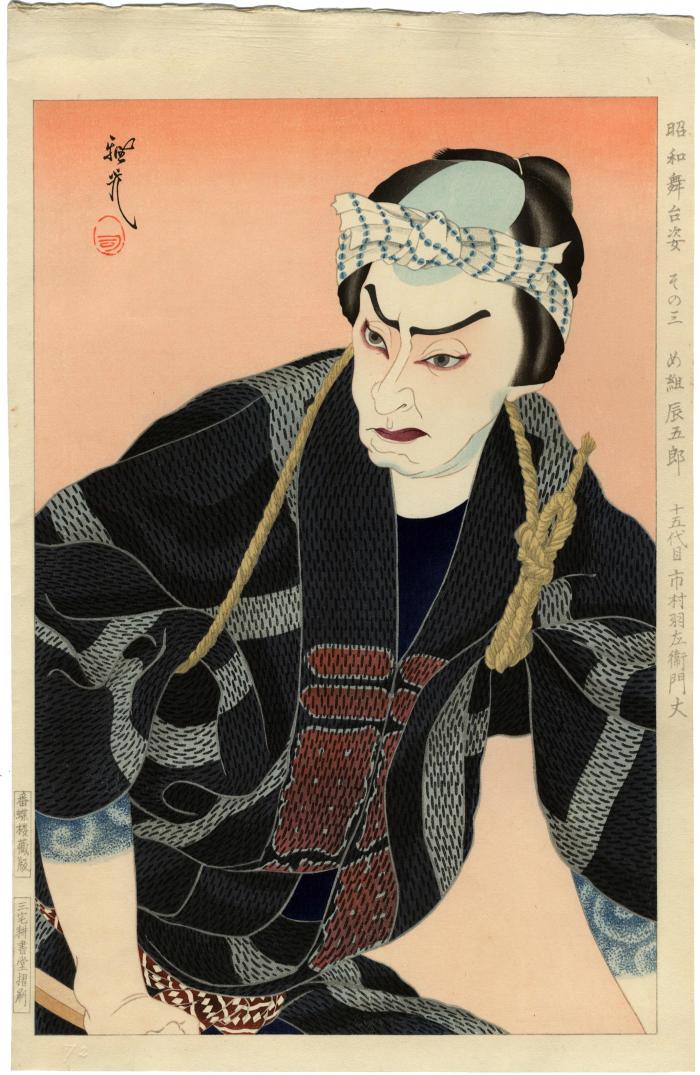Ōta Masamitsu (太田雅光) (artist 1892 – 1975)
Ichimura Uzaemon XV (十五代目 市村羽左衛門) as the fireman Tatsugorō of the Me(gumi) company in Megumi Tatsugorō (め組辰五郎) from the series 'Figures of the Stage during Shōwa' (昭和舞台姿), no. 3 (その三)
1945
10.375 in x 16 in (Overall dimensions) Japanese woodblock print
Signed: Masamitsu (雅光)
Artist's seal in red
Number - embossed in lower left: 72 [of 200]
Publisher: Banchōrō zohan
番蝶楼蔵版
Printer's seal: Miyake Koshodo shosatsu
三宅耕書堂摺摺刷
Waseda University
Portland Art Museum - they date this print to 1955 Tatsugorō is a major figure in a play written in 1890. "A band of Edo firefighters called the Megumi, enjoying themselves in a room at the Shimazakuro brothel in Shinagawa with their leader, Tatsugorō, are patiently enduring the raucous behavior of a bunch of drunken wrestlers in the next room. Suddenly, things get out of hand; a wrestler knocks over a shōji screen onto one of the firemen, Fujimatsu, and an angry quarrel is sparked, leading to a fight with the wrestlers Yotsuguruma and Aranami. But, realizing that if the fight goes on there will be hell to pay with the brothel, Tatsugorō bites the bullet and apologizes, calming things down. But he continues to seethe and soon after ambushes Yotsuguruma at Yatsu Yamashita, only to be defeated, losing his tobacco pouch in the process. Afterward, Kisaburō, an official who supplies food to the samurai, passes by in a palanquin and finds the pouch.
At a theatre on the grounds of the Shinmei Shrine, another altercation erupts between the drunken firemen and the wrestlers, with Yotsuguruma and Tatsugorō about to go head to head; but Aruji Kitarō, head of the acting company, intervenes, and both sides leave without further commotion. But Tatsugorō's rage keeps growing.
Tatsugorō's wife, Onaka, learns about the fighting and castigates him for his fecklessness, hoping to incite him to action, but Tatsugorō knows he must protect the honor of the firemen, even if it costs him his life, and he plans to take action that night when the wrestling matches are concluded.
The firemen, assembled in two places, converge on the sumō arena and begin a big rucku,s [sic] but Kisaburō rushes there with other officials, one of whom oversees the firemen while the other has jurisdiction over the wrestlers. Both sides agree to stop fighting, and all ends peaceably."
Quoted from: Historical Dictionary of Japanese Traditional Theatre by Samuel L. Leiter.
****
The zohan (蔵版) after the publisher's name in the left border means that they held the copyright.
****
Illustrated in color in Andon 87, the edition on Japanese tattooing, December, 2009, p. 99. The accompanying text says: "From about 1850 Edo firefighters were equipped with heavy multi-layered stitched coats (sashlko hanten), which could be soaked with water for protection against the heat of the flames. Depicted here is a fireman in a traditional black-and-grey patterned jacket on his way to an emergency/ suggested by the red glow in the background. The reddish logo on the lapel of the patterned coat identifies him as the leader of the ne firefighting squad, which protected the townspeople of Edo against fires. Tied around his head is a polka-dotted sweatband (hachimaki), which gives him a somewhat dashing and self-confident appearance. To allow free movements of his arms, the sleeves are tied up with a rope allowing a view of his tattoos. In his hand he holds a tobi guchi, used to tear down walls or break holes in the roof to allow a fire to burn vertically, rather than spreading horizontally.
The firefighter, played by the actor Ichimura Uzaemon XV, is Tatsugorō, one of the main characters in the Kabuki play A Quarrel in the Me Squad (Megumi no kenka). His role was modelled after a famous real-Iife fight between firemen and sumo wrestlers, which got badly out of hand. The worried expression on Tatsugorō's face reflects his fear of dying in the confrontation to come, leaving his wife and son behind."
****
This print is from an edition of 150.
actor prints (yakusha-e - 役者絵) (genre)
Ichimura Uzaemon XV (十五代目市村羽左衛門) (actor)
Banchōrō (番蝶楼) (publisher)
Shōwa era (昭和時代) (genre)
Tattoo (genre)
